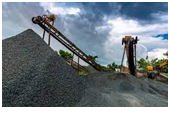Environmental Guidelines For Stone Crushing Units:
News: It has long been known that stone crushing operations are a significant source of fugitive dust emissions and severe air pollution.
The Central Pollution Control Board (CPCB) has released the Environmental Guidelines for Stone Crushing Units in response to the growing concern.
The recommendations issued by the non-profit Centre for Science and Environment (CSE), which has its headquarters in New Delhi, are in line with the principles.
Key Recommendations Announced By CPCB:
The CPCB recommendations cover a range of topics related to stone crushing, including source emissions, product storage, transportation, water use, and regulatory compliance.
Before beginning operations, stone crushers shall acquire permission from the State Pollution Control Board (SPCB) to create and operate (CTO).
The Environment (Protection) Rules, 1986’s emission standards, and the criteria outlined in the CTO by the relevant SPCB/PCC, must be complied with by stone crushing units.
To limit the dust emissions from crushing, loading, and unloading operations, they should install sufficient pollution control equipment, such as dust suppression systems, covers, screens, and sprinklers.
To avoid wind-blown dust, they should also keep their goods in covered spaces or silos.
The stone crushers must use water wisely, guarantee its availability and quality, buy their raw materials legally, and keep accurate records of their business dealings.
In order to regularly conduct surprise inspections for surveillance of stone crushing units located within their authority, a District Level Committee will be established under the direction of the District Magistrate/Deputy Commissioner.
The stone crusher should conduct a worker health survey every six months.




